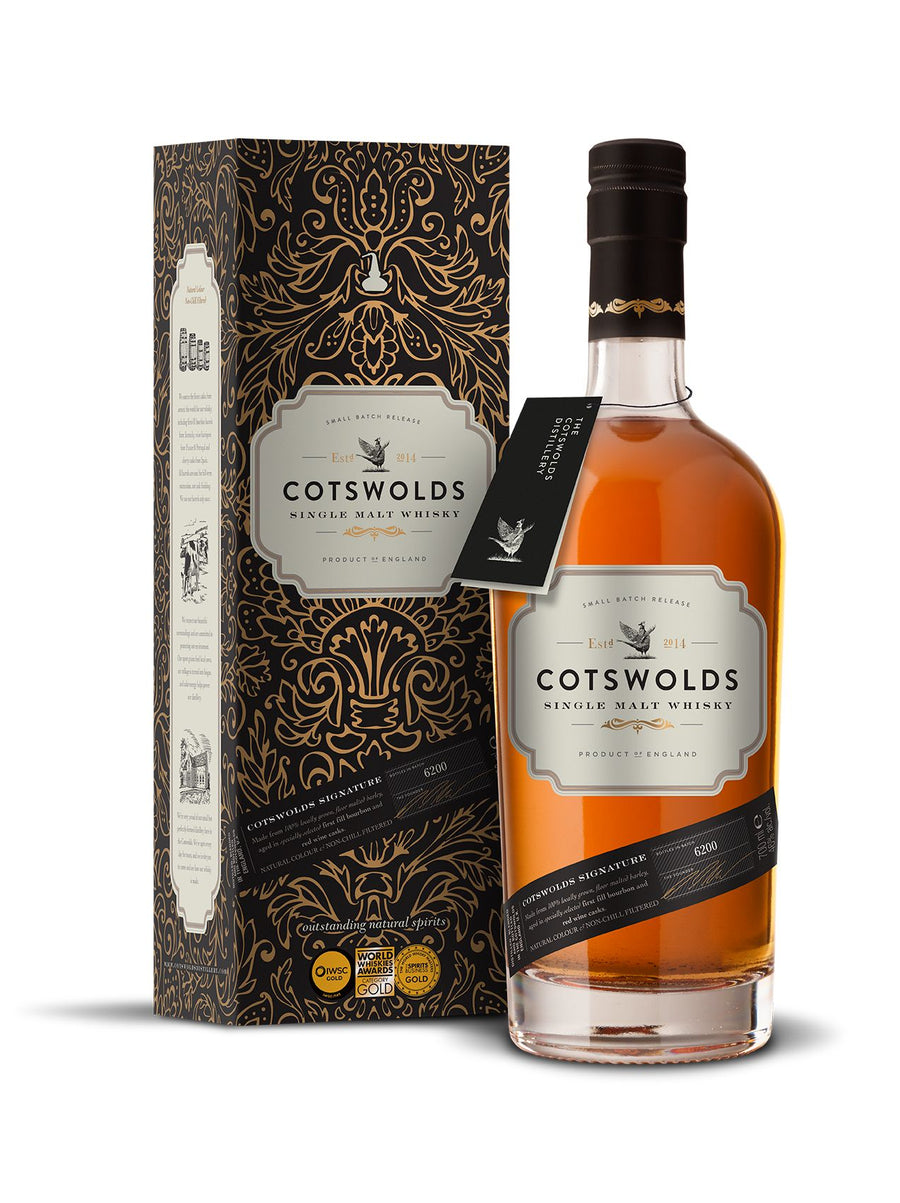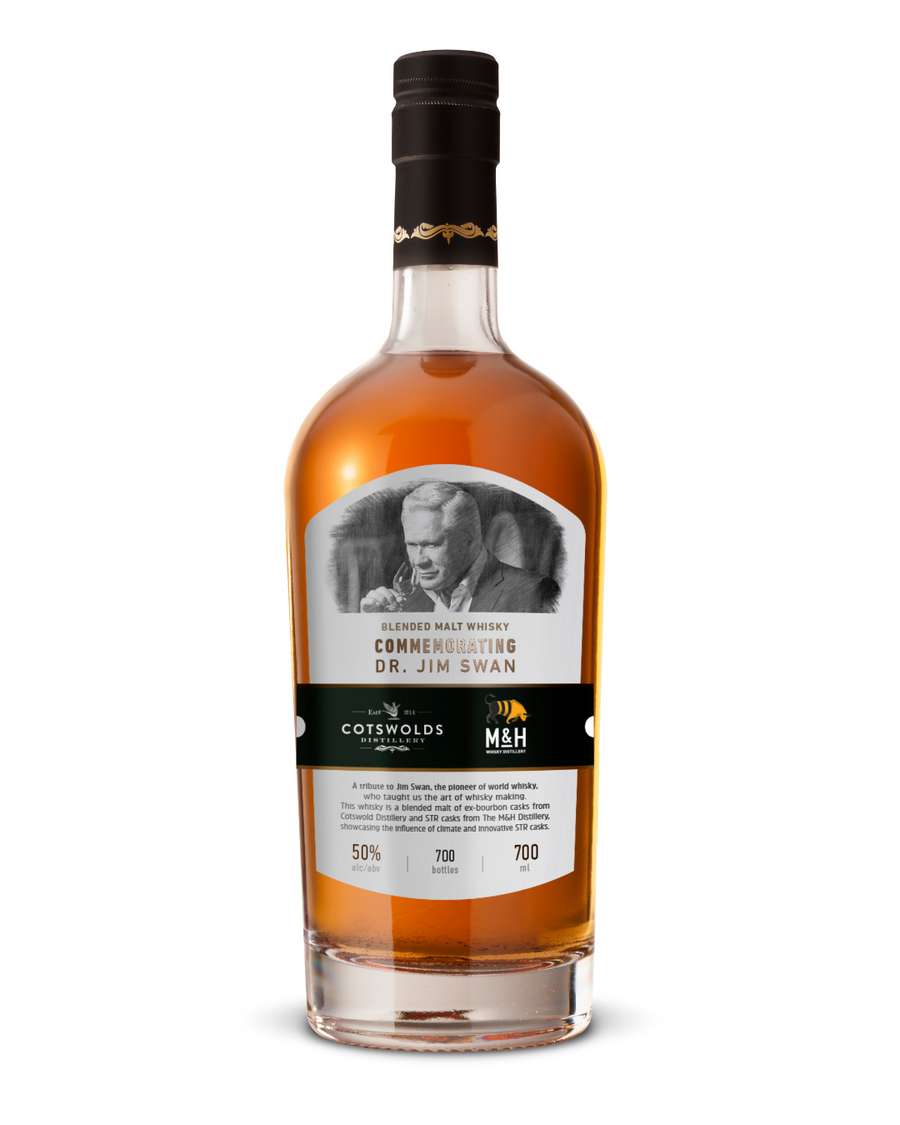Indulge in Rich Single Malt - the Smoothest Whisky from The Cotswolds Distillery
At The Cotswolds Distillery, whisky making is more than tradition; it’s an art form. Every sip of our single malt captures the richness of the English countryside, delivering indulgent flavours that reflect our commitment to excellence. By combining premium locally-sourced barley, meticulous distillation techniques, and carefully selected casks, we create whiskies that are both smooth and full of character.
From the tropical fruit notes born of our unique fermentation process to the deep, complex flavours imparted by STR ex-red wine and Bourbon casks, every stage of production is designed to build richness. It’s about balance, precision, and allowing nature’s elements to shine through. Whether you’re savouring the bold intensity of our Founder's Choice or the harmonious decadence of our Signature Single Malt, each dram embodies the expertise and passion that make Cotswolds whisky truly exceptional.
- The art of crafting smooth and rich single malt
- Indulgent and smooth whiskies from The Cotswolds Distillery
- Is the smoothness of whisky a sign of quality?
- Demystifying decadence: What does richness mean?
Taking single malt to new dimensions with meticulous production methods
Characteristic of the richness of the landscape, Cotswolds whisky is decadence in a glass
Ten-year-old whisky can taste smoother, but smoothness isn’t always a sign of age or quality
Richness is achieved at every stage of production: learn why Cotswolds is so delightful
The Art of Crafting Smooth and Rich Single Malt
Crafting single malt whisky is a marriage between science and art. The beautiful English landscape of the Cotswolds offers the highest quality barley. The master distiller controls every stage of whisky production to ensure the utmost quality, precision and consistent outcome. Richness builds with every stage. Distillation, ageing, blending and bottling decisions are key in determining the smoothness and complexity of the final spirit.
If you didn’t already know, Cotswolds Distillery is big on flavour.
“We’re not creating a spirit where the flavour needs to be created by the wood but creating a spirit that is really fruity grappa/eau de vie-style that can be accentuated by the barrels.
We’re already pre-loading flavour in production so the barrels can just add more flavour. It’s about assessing each stage of production - does it make more flavour? If the answer is yes, let’s do that.”
- Rob Patchett, Global Whisky Ambassador for The Cotswolds Distillery
Unique Fermentation Process Creates Big Flavours
The first phase of creating bold flavours in Cotswolds whisky is fermentation. Combining quality ingredients, carefully selected yeast strains, and a long fermentation window allows our barley ‘beer’ (also called the wash) to accumulate big tropical fruit and orchard fruit flavours, among other aromatics. These flavours are preserved via our distillation process, resulting in an unctuous final product.

Distilling A Balance Between Rich and Smooth Whisky
One of the key stages in creating a balanced but decadent spirit is distillation. Single malt typically uses batch distillation in copper pot stills. After the first distillation, the heart cut reaches around 50% ABV, and it’s packed with citrus and tropical fruit. At this stage, rougher compounds make it into the distillate. After the second distillation, those rough compounds are filtered out. Precise cut points ensure the final product is smooth without sacrificing its distinct palate.
What makes a whisky smooth
- Balanced alcohol: reaching a higher ABV leaves a harsh but milder-tasting spirit, while a lower ABV can leave more impurities and flavour. Getting the right balance ensures smoothness and richness in equal measure.
- Precision cut points: cutting off distillation earlier leaves a much purer spirit with fewer impurities; later, and you’ll get some rougher compounds in the final product. The key to smooth and rich whisky is precise cut points that eliminate roughness but maintain a full-bodied palate.
Maturation - the key to a Complex and smooth Spirit
Carefully selecting barrels for maturation is key for building on an already rich flavour profile and cutting through any harshness. Oloroso Sherry casks or sweet oak Bourbon casks are a popular choice, especially in single malt Scotch Whisky production. However, English Whisky can use any barrel seasonings such as rum, Moscatel, vermouth or Pineau Des Charentes. Scraped, Toasted and Re-charred (STR) barrels, recycled from wine production, give rich dark chocolate notes with a touch of cinnamon and spice.

Each barrel adds subtle flavours from the liquid previously aged in it, such as sweet raisins from Pedro Ximinez Sherry, fruit, cocoa and spice notes from red wine casks. You could expect honey and notes of vanilla from Bourbon barrels or brown sugar and orchard fruits from ex-rum casks.
The type of oak influences the flavours of the whisky too, American oak casks, used in Bourbon and wine maturation, impart sweetness, vanilla and toasted flavours such as toffee and toasted marshmallow. European oak is more savoury with herbaceous, earthy and peppery characteristics. Japanese oak, although rarely used in our distillery, can offer floral notes as well as orange peel. Old casks that have been used many times also won’t impart as much flavour as first-fill casks.
The length of maturation also plays a part in the final flavour outcome. The more exchange that occurs between the barrel and the liquid, the more complex the flavour. Full-term maturation in seasoned barrels and old whisky will have the richest profile.
“we’re discovering flavour profiles which are equivalent of those age statements [at a younger age], which means all of a sudden, a six-year-old whisky with a greater angels’ share has as much depth as a twelve or a fifteen-year-old Scotch...
...everything we’ve been ageing in the Cotwolds full-term is so much more expressive, it has bigger flavours and there is so much more extraction”
- Rob Patchett, Global Whisky Ambassador for The Cotswolds Distillery
Finally, the ageing process is key to creating the smoothest whisky. The compounds in the wood mellow out some of the sharper, harsher flavours, so the longer the liquid spends in the barrel (or at least the more exchange that occurs), the smoother the final product.
Blending and Bottling Decisions
After the master distiller has decided a whisky has spent enough time in the barrel, it’s time for blending, filtering and then bottling. There are some key decisions that influence the richness and smoothness of the final bottle.
Blending Artistry
It’s common to combine single malts that have aged in different types of barrels to create a balanced and unique profile. A master blender decides which barrels to blend, and the mix may spend some time ‘marrying’ in a final cask before bottling to create a perfect harmony of flavour.

Deciding whether to Dilute: Bottling Process
Most whiskies are bottled at around 40% ABV (bottle strength). However, the whisky in the cask usually sits around 55-60% after completing maturation. The head distiller decides whether to dilute the whisky before bottling to make for a smoother spirit with less burn. Cask strength whisky is bottled straight from the cask, without dilution. Chill filtration also makes for a smoother, cleaner spirit.
Indulgent and Smooth Whiskies from The Cotswolds Distillery
Cotswolds Signature Single Malt Whisky
The first whisky ever made in the Cotswolds, our award-winning Cotswolds Signature Single Malt Whisky is crafted using the finest locally grown, traditionally floor-malted Cotswold barley.
Our Signature Single Malt offers rich and bold, fruity notes which result from maturation in our highly ex-red wine barrels. The double cask single malt blends whisky matured in premium first-fill ex-Bourbon barrels and STR barriques. You’ll get notes of honey, red fruit, cherries and a hint of treacle – a decadent but balanced dram.

Founder's Choice Single Malt Whisky

Our cask strength Founder's Choice Single Malt Whisky is aged exclusively in our founder's favourite casks: STR (Shaved, Toasted and Re-charred) ex-red wine barrels.
These highly active casks were created by our mentor and renowned whisky consultant, the late Dr. Jim Swan, and give a rich and intense maturation to our fruit-forward spirit, offering strong notes of toffee, chocolate and red fruits, as well as a beautiful, deep colour.
Blended Malt Whisky Commemorating Dr Jim Swan
Introducing a Blended Malt Whisky, created in collaboration with Milk and Honey Whisky Distillery, celebrates the innovative spirit of Dr.Jim Swan. Known for his pioneering 'STR Cask'.
This limited-edition blend brings together select casks from two distilleries to create depth and a nuanced flavour profile. Ideal for those who appreciate a refined, balanced and smooth dram

Harvest Series: Golden Wold Single Malt Whisky

Our limited edition Golden Wold Single Malt Whisky is the first release in our Harvest Series and is a blend of select ex-Bourbon, STR red wine and Peated casks. This smooth and mellow blend shows off the rich and fruity character of our single malt spirit with a touch of peat smoke.
Is the Smoothness of Whisky a Sign of Quality?
Smoothness in whisky can indicate quality, especially when it’s the result of careful production, cask selection and blending. However, some whisky types are smoother than others, such as Single Malt and Bourbon.
While personal preferences vary, a smooth whisky often reflects meticulous distillation, maturation processes and longer maturation periods overall.
Demystifying Decadence - What does Richness Mean?
Richness can be achieved at every stage of production, and while smoothness is about creating balance, decadence is about building flavour. Explore some of the ways Cotswolds Distillery builds richness in every bottle:
What makes Cotswolds Whisky so Rich and Smooth?
- Long fermentation periods build rich fruit flavours such as banana, pineapple, pears and apricot
- Careful cut points allow aromatic compounds such as fruity esters, oils and fatty acids to make it through distillation while leaving behind rougher elements.
- Cask selection: STR ex-red wine casks add a rich decadence to many of the whiskies on offer.
- The warmer climate of the Cotswolds allows the wood to exchange with the liquid at a faster rate – building a complex flavour profile in a shorter time (compared to Scotch).
- Our award-winning blenders use their expert knowledge to craft beautifully rich and balanced flavour profiles that you’ve never experienced before.
“We’re two degrees latitude south of Scotland, and that little bit more warmth allows those barrels to open up and breathe, imparting more colour and flavour onto the whisky, which is always beneficial”
- Rob Patchett, Global Whisky Ambassador for The Cotswolds Distillery
Try a bottle of Cotswolds Single Malt Whisky
Frequently Asked Questions
Can you distinguish rich whisky from its colour?
A whisky's colour can suggest how long it has been in oak and the type of casks that were used. STR (Scraped, Toasted and Re-charred), ex-red wine casks give a real depth of flavour and colour. However, some whiskies add caramel colouring, which can be misleading if you’re selecting a product based on the hue. All of Cotswolds Distillery's whiskies are naturally coloured from maturation.
What are common misconceptions about blended whiskies?
Many people think that blended whiskies are smoother or milder than single malt whiskies. However, whisky blending is an art. Selecting malts and harmonising flavours from different distilleries can create a depth of flavour not achievable in a single malt. Blended whiskies can often be smooth and approachable too - it all depends on the skill of the blender.
How can you make a whisky smoother to drink?
Adding ice or a few drops of water to your glass is the easiest way to take away some of the burn from alcohol. Don’t worry about offending whisky lovers, the bottle strength is your starting point. You could also make a soda highball to soften the intensity of the spirit.
What to read next
Choosing the best spicy whisky
Choosing the best sweet and fruity whisky
Choosing a light and citrussy single malt
Choosing a lightly peated single malt

